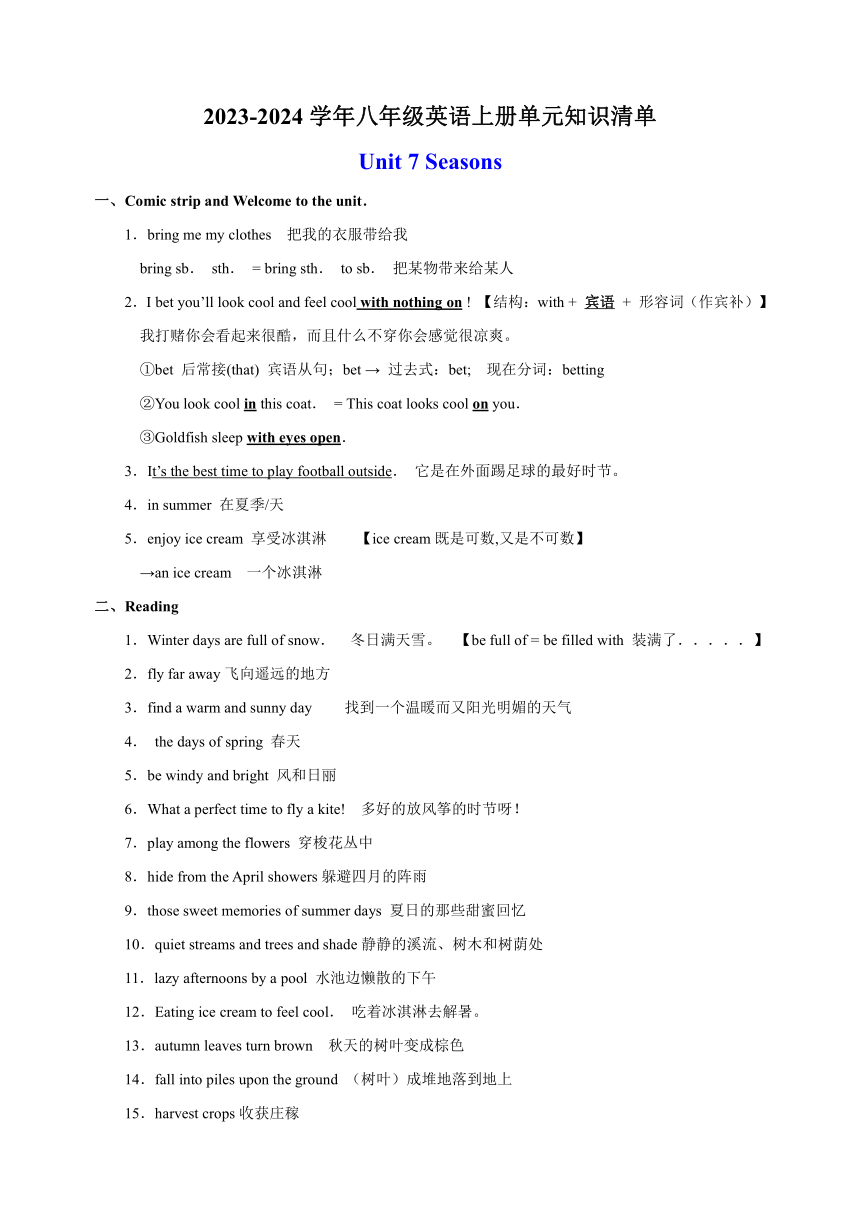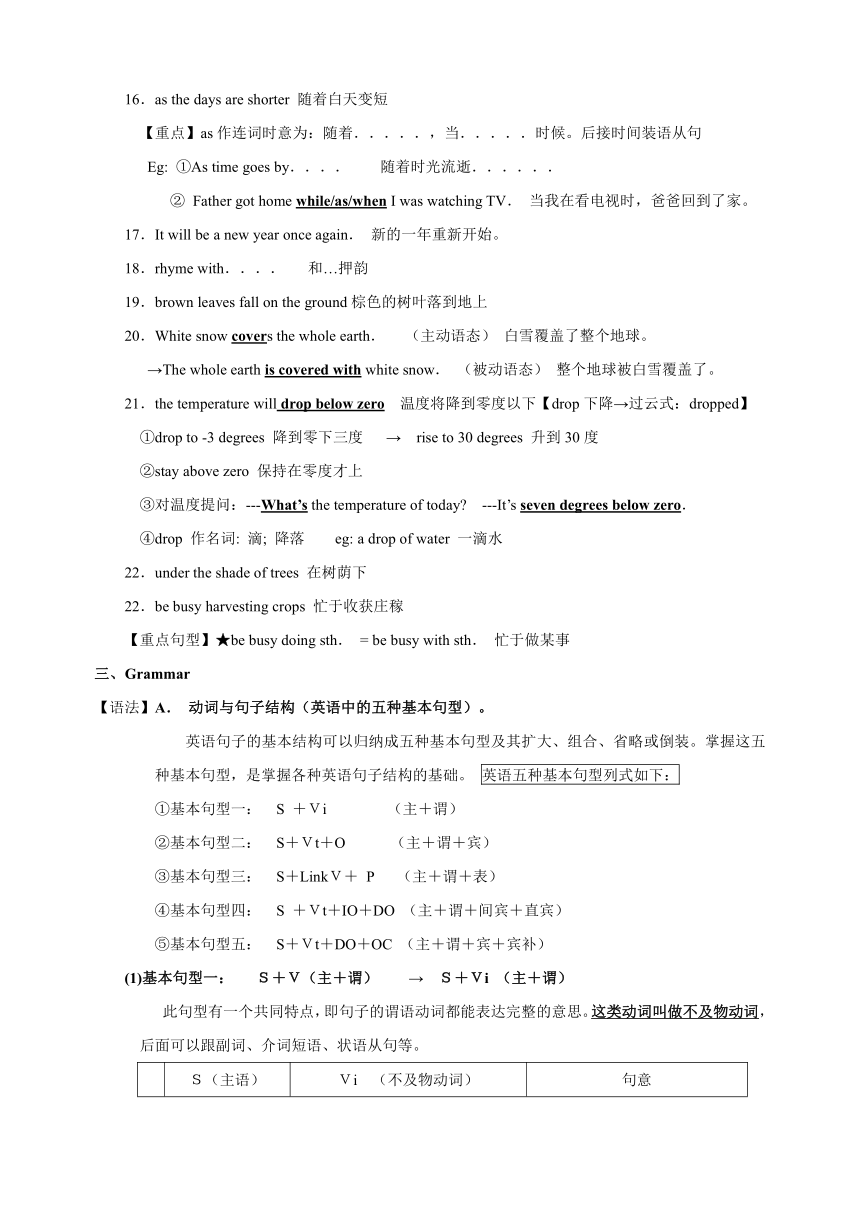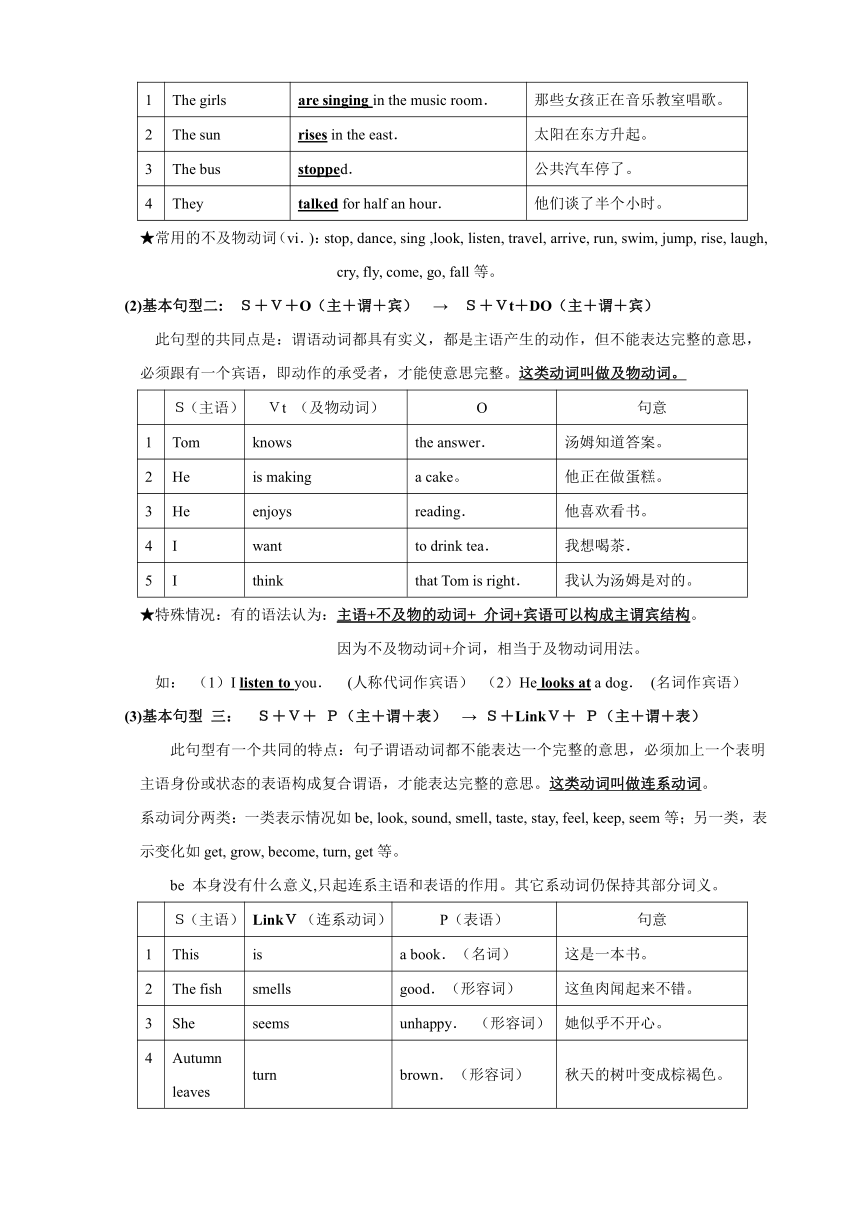2023-2024学年译林版八年级英语上册Unit 7 Seasons知识清单
文档属性
| 名称 | 2023-2024学年译林版八年级英语上册Unit 7 Seasons知识清单 |  | |
| 格式 | doc | ||
| 文件大小 | 111.5KB | ||
| 资源类型 | 教案 | ||
| 版本资源 | 牛津译林版 | ||
| 科目 | 英语 | ||
| 更新时间 | 2024-02-16 09:52:07 | ||
图片预览




文档简介
2023-2024学年八年级英语上册单元知识清单
Unit 7 Seasons
一、Comic strip and Welcome to the unit.
1.bring me my clothes 把我的衣服带给我
bring sb. sth. = bring sth. to sb. 把某物带来给某人
2.I bet you’ll look cool and feel cool with nothing on ! 【结构:with + 宾语 + 形容词(作宾补)】
我打赌你会看起来很酷,而且什么不穿你会感觉很凉爽。
①bet 后常接(that) 宾语从句;bet → 过去式:bet; 现在分词:betting
②You look cool in this coat. = This coat looks cool on you.
③Goldfish sleep with eyes open.
3.It’s the best time to play football outside. 它是在外面踢足球的最好时节。
4.in summer 在夏季/天
5.enjoy ice cream 享受冰淇淋 【ice cream既是可数,又是不可数】
→an ice cream 一个冰淇淋
二、Reading
1.Winter days are full of snow. 冬日满天雪。 【be full of = be filled with 装满了.....】
2.fly far away飞向遥远的地方
3.find a warm and sunny day 找到一个温暖而又阳光明媚的天气
4. the days of spring 春天
5.be windy and bright 风和日丽
6.What a perfect time to fly a kite! 多好的放风筝的时节呀!
7.play among the flowers 穿梭花丛中
8.hide from the April showers躲避四月的阵雨
9.those sweet memories of summer days 夏日的那些甜蜜回忆
10.quiet streams and trees and shade静静的溪流、树木和树荫处
11.lazy afternoons by a pool 水池边懒散的下午
12.Eating ice cream to feel cool. 吃着冰淇淋去解暑。
13.autumn leaves turn brown 秋天的树叶变成棕色
14.fall into piles upon the ground (树叶)成堆地落到地上
15.harvest crops收获庄稼
16.as the days are shorter 随着白天变短
【重点】as作连词时意为:随着.....,当.....时候。后接时间装语从句
Eg: ①As time goes by.... 随着时光流逝......
② Father got home while/as/when I was watching TV. 当我在看电视时,爸爸回到了家。
17.It will be a new year once again. 新的一年重新开始。
18.rhyme with.... 和…押韵
19.brown leaves fall on the ground棕色的树叶落到地上
20.White snow covers the whole earth. (主动语态) 白雪覆盖了整个地球。
→The whole earth is covered with white snow. (被动语态) 整个地球被白雪覆盖了。
21.the temperature will drop below zero 温度将降到零度以下【drop下降→过云式:dropped】
①drop to -3 degrees 降到零下三度 → rise to 30 degrees 升到30度
②stay above zero 保持在零度才上
③对温度提问:---What’s the temperature of today ---It’s seven degrees below zero.
④drop 作名词: 滴; 降落 eg: a drop of water 一滴水
22.under the shade of trees 在树荫下
22.be busy harvesting crops 忙于收获庄稼
【重点句型】★be busy doing sth. = be busy with sth. 忙于做某事
三、Grammar
【语法】A. 动词与句子结构(英语中的五种基本句型)。
英语句子的基本结构可以归纳成五种基本句型及其扩大、组合、省略或倒装。掌握这五种基本句型,是掌握各种英语句子结构的基础。 英语五种基本句型列式如下:
①基本句型一: S +Vi (主+谓)
②基本句型二: S+Vt+O (主+谓+宾)
③基本句型三: S+LinkV+ P (主+谓+表)
④基本句型四: S +Vt+IO+DO (主+谓+间宾+直宾)
⑤基本句型五: S+Vt+DO+OC (主+谓+宾+宾补)
(1)基本句型一: S+V(主+谓) → S+Vi (主+谓)
此句型有一个共同特点,即句子的谓语动词都能表达完整的意思。这类动词叫做不及物动词,后面可以跟副词、介词短语、状语从句等。
S(主语) Vi (不及物动词) 句意
1 The girls are singing in the music room. 那些女孩正在音乐教室唱歌。
2 The sun rises in the east. 太阳在东方升起。
3 The bus stopped. 公共汽车停了。
4 They talked for half an hour. 他们谈了半个小时。
★常用的不及物动词(vi.):stop, dance, sing ,look, listen, travel, arrive, run, swim, jump, rise, laugh, cry, fly, come, go, fall等。
(2)基本句型二: S+V+O(主+谓+宾) → S+Vt+DO(主+谓+宾)
此句型的共同点是:谓语动词都具有实义,都是主语产生的动作,但不能表达完整的意思,
必须跟有一个宾语,即动作的承受者,才能使意思完整。这类动词叫做及物动词。
S(主语) Vt (及物动词) O 句意
1 Tom knows the answer. 汤姆知道答案。
2 He is making a cake。 他正在做蛋糕。
3 He enjoys reading. 他喜欢看书。
4 I want to drink tea. 我想喝茶.
5 I think that Tom is right. 我认为汤姆是对的。
★特殊情况:有的语法认为:主语+不及物的动词+ 介词+宾语可以构成主谓宾结构。
因为不及物动词+介词,相当于及物动词用法。
如: (1)I listen to you. (人称代词作宾语) (2)He looks at a dog. (名词作宾语)
(3)基本句型 三: S+V+ P(主+谓+表) → S+LinkV+ P(主+谓+表)
此句型有一个共同的特点:句子谓语动词都不能表达一个完整的意思,必须加上一个表明主语身份或状态的表语构成复合谓语,才能表达完整的意思。这类动词叫做连系动词。
系动词分两类:一类表示情况如be, look, sound, smell, taste, stay, feel, keep, seem等;另一类,表示变化如get, grow, become, turn, get等。
be 本身没有什么意义,只起连系主语和表语的作用。其它系动词仍保持其部分词义。
S(主语) LinkV (连系动词) P(表语) 句意
1 This is a book.(名词) 这是一本书。
2 The fish smells good.(形容词) 这鱼肉闻起来不错。
3 She seems unhappy. (形容词) 她似乎不开心。
4 Autumn leaves turn brown.(形容词) 秋天的树叶变成棕褐色。
5 My dream is to be a doctor.(不定式) 我的梦想是当一名医生。
★本结构是由主语+系动词+表语组成。系动词有:
(1)表示特征和存在状态的: be, seem, feel, look, smell, taste, sound;
(2)表示状态延续的: stay, keep
(3)表示状态变化的 become, get, turn, go, run, fall, come, grow
(4)基本句型四: S +Vt + IO +DO(主+谓+间宾+直宾)
此句型有一个共同特点:谓语动词必须跟有两个宾语才能表达完整的意思。这两个宾语一个是动的直接承受者(多指物),另一个是动作的间接承受者(多指人)。
S(主语) Vt (及物动词)) IO(间接宾语,常为人) DO(直接宾语,常为物)
1 Mother is making me a new dress.
2 He bought his son a new bike.
3 They offered us much help.
4 I am showing him my photos.
5 Jack tells us funny stories.
★当这一间接承受者放在直接承受者之后时,要用一个介词(for或to)来连接。可以用于这种句式动词主要有:
(A) buy / build / catch / cut /choose / cook / find / get / keep / make / draw / do 【用for】
如:He bought me a new bike. 也可以改为for sb. 的句式
= He bought a new bike for me.
(B) give / take / send / bring / teach / show / tell / pay / write / read / sell / lend / pass / return /
throw / offer / hand 【用to】
如:She lent me a book. 也可以改为 to sb. 的句式 = She lent a book to me.
(C) provide 【用for, with】: provide sb. with sth. = provide sth.for sb.
注意:当两宾语都为代词时,必须用介词把人放后面。Eg: Please give it to me.
(5)基本句型五: S+V+DO+OC → S+Vt+DO+OC (主+谓+宾+宾补)
此句型的共同特点是:动词虽然是及物动词,但是只跟一个宾语还不能表达完整的意思,必须加上一个补充成分来补足宾语,才能使意思完整,补足语说明宾语的状态或情况或动作由宾语去执行,宾语补足语可能是:形容词、名词、动词不定式或现在分词短语等。
S(主语) Vt (及物动词)) DO(直接宾语) OC(宾语补足语)
1 I find English easy. (形容词)
2 Tom often makes us happy. (形容词)
3 I think Kate a clever girl.(名词短语)
3 Tom often makes us laugh.(不定式)
4 He asked me to come back soon.(不定式)
5 We call her Xiao Li.(名词)
8 I saw them dancing. (现在分词短语)
★可以用于这种句式的动词主要有:
(A)let / have / make sb. do sth.
(B)ask / want / tell / allow / wish / get / expect / encourage / invite / teach sb. to do sth.
(C)find / see / hear / watch / notice / feel sb. do sth./sb. doing sth.
(D)help sb. (to) do sth
(E)find/keep/think/make/leave/wish + 宾语 + 形容词或名词性短语(作宾补)
【语法】B. 重点短语句型
1.fall from morning till night (雨)从早下到晚 【fall 倒下、掉下→ 过云式:fell】
2.kick the ball 踢球
3.catch a bad cold = have a bad cold 得了重感冒
4.have a high fever 发高烧
5.cough a lot 咳嗽厉害
6.It was an awful day! 这是多糟糕的一天啊!
四、Integrated skills
1.listen to the weather report on the radio 在收音机上听天气报告
2.snowstorms from the north 来自北方的暴风雪
3.arrive in the late afternoon 午后晚些时候到达
4.drop to -10 ℃ 降到零下十度 【-10 ℃ 读作:ten degrees below zero或 minus ten degrees】
5.be mainly dry and sunny 以干燥和阳光为主
6.be around 9 ℃ during the day 白天期间大约9度
7.with temperature in the thirties (伴随)气温三十几度
【拓展】in one’s + 数词复数 → 在某人几十岁时 eg: in his 30s/thirties 在他三十几岁时
8.stay with us for the rest of the week 这周剩下的日子和我们待一起
9.daytime temperature around 18 or 19 degrees 白天的气温大约18或者19度
10.the highest (lowest) temperature 最高(底)气温
11.stay above zero 保持在零度以上
12.during this time of year 在每年的这个时节里
13.How is the weather in Nanjing = What’s the weather like in Nanjing 南京的天气如何?
14.How are you doing 你过的怎样?
15.a strong snowstorm 一场强暴风雪
16.a bit cold = a little cold 一点冷 【回顾:a bit of milk = a little milk】
【区分】 ★在修饰形容词或副词时:a bit = a little
★在修饰不可数名词时:a bit of = a little
17.blow hard 猛烈地吹 【blow 吹→ 过云式:blew】
18.speak loud = speak loudly 大声说 【speak louder = speak more loudly】
注:【read aloud大声读】【loud 形容词或副词;aloud和loudly为副词】
Eg: Actions speak louder than words. 事实胜于雄辩。
19.ring sb. (up) = call sb.(up) = phone sb. = telephone sb. = make a telephone call to sb.
给某人打电话 【ring→ 过云式:rang】
20.--- Sorry, I can’t hear you. ---That’s OK. 没关系。
用英语表达“没关系”的方式:
(1). That's OK! 没关系! (2). That's alright! 没关系! (3). It's nothing! 没什麼!
(4). Never mind! 没关系!别放在心上! (5). It doesn't matter! 没关系!
21.比较:①It will be sunny in New York. ②There will be showers in Sydney.
★【区分】①It will be rainy(形)tomorrow. 【It will be + 形容词】
②There will be rain(名)tomorrow. 【There will be + 名词】
五、Study skills
名词 + y构成形容词。
直接+y 直接+y
cloud cloudy luck lucky
wind windy health healthy
rain rainy sleep sleepy(困倦的、想睡的)
snow snowy sport sporty (爱好运动的)
storm(暴风雨) stormy(有暴风雨的)
frost(霜冻) frosty(有霜冻的)
双写最后辅音字母后+y 去掉不发音的e后+y
sun sunny shine(光亮) shiny(闪闪发光的)
fog foggy noise noisy
fun funny ice icy(结冰的; 冰冷的)
重点短语句型:
1.cover their faces with scarves 用围巾捂/盖住脸 【注:scarf→复数:scarves或scarfs】
2.The high temperature makes people sleepy. 高温让人们昏昏欲睡。
3.the sudden heavy rain 那场突如其来的大雨【注:sudden形容词→副词:suddenly】
4.cause a lot of problems 引起许多问题
【重点】 ①cause 作动词:引起,使发生 →常与lead to 同义转化
②cause 作名词:原因(与reason使用时有区别)
★Carelessness is the cause of his failure. 粗心是他失败的原因。
★The reason for the flood was that heavy rain. 那场大雨是发生洪水的原因。
5.the best season of the year 一年中最好季节
6.have a short trip around the city 进行环城的短途旅游
7.on snowy days 在下雪的日子
六、Task
1.be covered in deep white snow 被深深的白雪覆盖
2. have (big) snowball fights 打雪仗
3.We throw snowballs at each other , screaming and laughing. 【现在分词短语作伴随状语】
我们互相扔雪球,(同时)伴随着尖叫声、大笑声。 【throw→ 过云式:threw】
①throw snowballs at each other 互相扔雪球 【throw sth. at sb.朝某人仍某物】
②screaming and laughing
★现在分词短语作伴随状语:表示此动作伴随其它动作同时发生。前在常有一个逗号。
Eg: The teacher came into the classroom, holding a book in his hand.
老师走进教室的同时,伴随着另一动作:手里拿着一本书。
=The teacher came into the classroom with a book in his hand.
4.make a snowman / make snowmen 堆雪人【注:snowman合成词→复数:snowmen】
5.use carrots for their noses 用胡萝卜做鼻子 【★use sth. for sth.】
【重点】★use sth. to do sth. = use sth. for doing sth.
Eg: We use the key to open the door.
= We use the key for opening the door.
= We open the door with the key.
6.the Ice Festival 冰雪节
Unit 7 Seasons
一、Comic strip and Welcome to the unit.
1.bring me my clothes 把我的衣服带给我
bring sb. sth. = bring sth. to sb. 把某物带来给某人
2.I bet you’ll look cool and feel cool with nothing on ! 【结构:with + 宾语 + 形容词(作宾补)】
我打赌你会看起来很酷,而且什么不穿你会感觉很凉爽。
①bet 后常接(that) 宾语从句;bet → 过去式:bet; 现在分词:betting
②You look cool in this coat. = This coat looks cool on you.
③Goldfish sleep with eyes open.
3.It’s the best time to play football outside. 它是在外面踢足球的最好时节。
4.in summer 在夏季/天
5.enjoy ice cream 享受冰淇淋 【ice cream既是可数,又是不可数】
→an ice cream 一个冰淇淋
二、Reading
1.Winter days are full of snow. 冬日满天雪。 【be full of = be filled with 装满了.....】
2.fly far away飞向遥远的地方
3.find a warm and sunny day 找到一个温暖而又阳光明媚的天气
4. the days of spring 春天
5.be windy and bright 风和日丽
6.What a perfect time to fly a kite! 多好的放风筝的时节呀!
7.play among the flowers 穿梭花丛中
8.hide from the April showers躲避四月的阵雨
9.those sweet memories of summer days 夏日的那些甜蜜回忆
10.quiet streams and trees and shade静静的溪流、树木和树荫处
11.lazy afternoons by a pool 水池边懒散的下午
12.Eating ice cream to feel cool. 吃着冰淇淋去解暑。
13.autumn leaves turn brown 秋天的树叶变成棕色
14.fall into piles upon the ground (树叶)成堆地落到地上
15.harvest crops收获庄稼
16.as the days are shorter 随着白天变短
【重点】as作连词时意为:随着.....,当.....时候。后接时间装语从句
Eg: ①As time goes by.... 随着时光流逝......
② Father got home while/as/when I was watching TV. 当我在看电视时,爸爸回到了家。
17.It will be a new year once again. 新的一年重新开始。
18.rhyme with.... 和…押韵
19.brown leaves fall on the ground棕色的树叶落到地上
20.White snow covers the whole earth. (主动语态) 白雪覆盖了整个地球。
→The whole earth is covered with white snow. (被动语态) 整个地球被白雪覆盖了。
21.the temperature will drop below zero 温度将降到零度以下【drop下降→过云式:dropped】
①drop to -3 degrees 降到零下三度 → rise to 30 degrees 升到30度
②stay above zero 保持在零度才上
③对温度提问:---What’s the temperature of today ---It’s seven degrees below zero.
④drop 作名词: 滴; 降落 eg: a drop of water 一滴水
22.under the shade of trees 在树荫下
22.be busy harvesting crops 忙于收获庄稼
【重点句型】★be busy doing sth. = be busy with sth. 忙于做某事
三、Grammar
【语法】A. 动词与句子结构(英语中的五种基本句型)。
英语句子的基本结构可以归纳成五种基本句型及其扩大、组合、省略或倒装。掌握这五种基本句型,是掌握各种英语句子结构的基础。 英语五种基本句型列式如下:
①基本句型一: S +Vi (主+谓)
②基本句型二: S+Vt+O (主+谓+宾)
③基本句型三: S+LinkV+ P (主+谓+表)
④基本句型四: S +Vt+IO+DO (主+谓+间宾+直宾)
⑤基本句型五: S+Vt+DO+OC (主+谓+宾+宾补)
(1)基本句型一: S+V(主+谓) → S+Vi (主+谓)
此句型有一个共同特点,即句子的谓语动词都能表达完整的意思。这类动词叫做不及物动词,后面可以跟副词、介词短语、状语从句等。
S(主语) Vi (不及物动词) 句意
1 The girls are singing in the music room. 那些女孩正在音乐教室唱歌。
2 The sun rises in the east. 太阳在东方升起。
3 The bus stopped. 公共汽车停了。
4 They talked for half an hour. 他们谈了半个小时。
★常用的不及物动词(vi.):stop, dance, sing ,look, listen, travel, arrive, run, swim, jump, rise, laugh, cry, fly, come, go, fall等。
(2)基本句型二: S+V+O(主+谓+宾) → S+Vt+DO(主+谓+宾)
此句型的共同点是:谓语动词都具有实义,都是主语产生的动作,但不能表达完整的意思,
必须跟有一个宾语,即动作的承受者,才能使意思完整。这类动词叫做及物动词。
S(主语) Vt (及物动词) O 句意
1 Tom knows the answer. 汤姆知道答案。
2 He is making a cake。 他正在做蛋糕。
3 He enjoys reading. 他喜欢看书。
4 I want to drink tea. 我想喝茶.
5 I think that Tom is right. 我认为汤姆是对的。
★特殊情况:有的语法认为:主语+不及物的动词+ 介词+宾语可以构成主谓宾结构。
因为不及物动词+介词,相当于及物动词用法。
如: (1)I listen to you. (人称代词作宾语) (2)He looks at a dog. (名词作宾语)
(3)基本句型 三: S+V+ P(主+谓+表) → S+LinkV+ P(主+谓+表)
此句型有一个共同的特点:句子谓语动词都不能表达一个完整的意思,必须加上一个表明主语身份或状态的表语构成复合谓语,才能表达完整的意思。这类动词叫做连系动词。
系动词分两类:一类表示情况如be, look, sound, smell, taste, stay, feel, keep, seem等;另一类,表示变化如get, grow, become, turn, get等。
be 本身没有什么意义,只起连系主语和表语的作用。其它系动词仍保持其部分词义。
S(主语) LinkV (连系动词) P(表语) 句意
1 This is a book.(名词) 这是一本书。
2 The fish smells good.(形容词) 这鱼肉闻起来不错。
3 She seems unhappy. (形容词) 她似乎不开心。
4 Autumn leaves turn brown.(形容词) 秋天的树叶变成棕褐色。
5 My dream is to be a doctor.(不定式) 我的梦想是当一名医生。
★本结构是由主语+系动词+表语组成。系动词有:
(1)表示特征和存在状态的: be, seem, feel, look, smell, taste, sound;
(2)表示状态延续的: stay, keep
(3)表示状态变化的 become, get, turn, go, run, fall, come, grow
(4)基本句型四: S +Vt + IO +DO(主+谓+间宾+直宾)
此句型有一个共同特点:谓语动词必须跟有两个宾语才能表达完整的意思。这两个宾语一个是动的直接承受者(多指物),另一个是动作的间接承受者(多指人)。
S(主语) Vt (及物动词)) IO(间接宾语,常为人) DO(直接宾语,常为物)
1 Mother is making me a new dress.
2 He bought his son a new bike.
3 They offered us much help.
4 I am showing him my photos.
5 Jack tells us funny stories.
★当这一间接承受者放在直接承受者之后时,要用一个介词(for或to)来连接。可以用于这种句式动词主要有:
(A) buy / build / catch / cut /choose / cook / find / get / keep / make / draw / do 【用for】
如:He bought me a new bike. 也可以改为for sb. 的句式
= He bought a new bike for me.
(B) give / take / send / bring / teach / show / tell / pay / write / read / sell / lend / pass / return /
throw / offer / hand 【用to】
如:She lent me a book. 也可以改为 to sb. 的句式 = She lent a book to me.
(C) provide 【用for, with】: provide sb. with sth. = provide sth.for sb.
注意:当两宾语都为代词时,必须用介词把人放后面。Eg: Please give it to me.
(5)基本句型五: S+V+DO+OC → S+Vt+DO+OC (主+谓+宾+宾补)
此句型的共同特点是:动词虽然是及物动词,但是只跟一个宾语还不能表达完整的意思,必须加上一个补充成分来补足宾语,才能使意思完整,补足语说明宾语的状态或情况或动作由宾语去执行,宾语补足语可能是:形容词、名词、动词不定式或现在分词短语等。
S(主语) Vt (及物动词)) DO(直接宾语) OC(宾语补足语)
1 I find English easy. (形容词)
2 Tom often makes us happy. (形容词)
3 I think Kate a clever girl.(名词短语)
3 Tom often makes us laugh.(不定式)
4 He asked me to come back soon.(不定式)
5 We call her Xiao Li.(名词)
8 I saw them dancing. (现在分词短语)
★可以用于这种句式的动词主要有:
(A)let / have / make sb. do sth.
(B)ask / want / tell / allow / wish / get / expect / encourage / invite / teach sb. to do sth.
(C)find / see / hear / watch / notice / feel sb. do sth./sb. doing sth.
(D)help sb. (to) do sth
(E)find/keep/think/make/leave/wish + 宾语 + 形容词或名词性短语(作宾补)
【语法】B. 重点短语句型
1.fall from morning till night (雨)从早下到晚 【fall 倒下、掉下→ 过云式:fell】
2.kick the ball 踢球
3.catch a bad cold = have a bad cold 得了重感冒
4.have a high fever 发高烧
5.cough a lot 咳嗽厉害
6.It was an awful day! 这是多糟糕的一天啊!
四、Integrated skills
1.listen to the weather report on the radio 在收音机上听天气报告
2.snowstorms from the north 来自北方的暴风雪
3.arrive in the late afternoon 午后晚些时候到达
4.drop to -10 ℃ 降到零下十度 【-10 ℃ 读作:ten degrees below zero或 minus ten degrees】
5.be mainly dry and sunny 以干燥和阳光为主
6.be around 9 ℃ during the day 白天期间大约9度
7.with temperature in the thirties (伴随)气温三十几度
【拓展】in one’s + 数词复数 → 在某人几十岁时 eg: in his 30s/thirties 在他三十几岁时
8.stay with us for the rest of the week 这周剩下的日子和我们待一起
9.daytime temperature around 18 or 19 degrees 白天的气温大约18或者19度
10.the highest (lowest) temperature 最高(底)气温
11.stay above zero 保持在零度以上
12.during this time of year 在每年的这个时节里
13.How is the weather in Nanjing = What’s the weather like in Nanjing 南京的天气如何?
14.How are you doing 你过的怎样?
15.a strong snowstorm 一场强暴风雪
16.a bit cold = a little cold 一点冷 【回顾:a bit of milk = a little milk】
【区分】 ★在修饰形容词或副词时:a bit = a little
★在修饰不可数名词时:a bit of = a little
17.blow hard 猛烈地吹 【blow 吹→ 过云式:blew】
18.speak loud = speak loudly 大声说 【speak louder = speak more loudly】
注:【read aloud大声读】【loud 形容词或副词;aloud和loudly为副词】
Eg: Actions speak louder than words. 事实胜于雄辩。
19.ring sb. (up) = call sb.(up) = phone sb. = telephone sb. = make a telephone call to sb.
给某人打电话 【ring→ 过云式:rang】
20.--- Sorry, I can’t hear you. ---That’s OK. 没关系。
用英语表达“没关系”的方式:
(1). That's OK! 没关系! (2). That's alright! 没关系! (3). It's nothing! 没什麼!
(4). Never mind! 没关系!别放在心上! (5). It doesn't matter! 没关系!
21.比较:①It will be sunny in New York. ②There will be showers in Sydney.
★【区分】①It will be rainy(形)tomorrow. 【It will be + 形容词】
②There will be rain(名)tomorrow. 【There will be + 名词】
五、Study skills
名词 + y构成形容词。
直接+y 直接+y
cloud cloudy luck lucky
wind windy health healthy
rain rainy sleep sleepy(困倦的、想睡的)
snow snowy sport sporty (爱好运动的)
storm(暴风雨) stormy(有暴风雨的)
frost(霜冻) frosty(有霜冻的)
双写最后辅音字母后+y 去掉不发音的e后+y
sun sunny shine(光亮) shiny(闪闪发光的)
fog foggy noise noisy
fun funny ice icy(结冰的; 冰冷的)
重点短语句型:
1.cover their faces with scarves 用围巾捂/盖住脸 【注:scarf→复数:scarves或scarfs】
2.The high temperature makes people sleepy. 高温让人们昏昏欲睡。
3.the sudden heavy rain 那场突如其来的大雨【注:sudden形容词→副词:suddenly】
4.cause a lot of problems 引起许多问题
【重点】 ①cause 作动词:引起,使发生 →常与lead to 同义转化
②cause 作名词:原因(与reason使用时有区别)
★Carelessness is the cause of his failure. 粗心是他失败的原因。
★The reason for the flood was that heavy rain. 那场大雨是发生洪水的原因。
5.the best season of the year 一年中最好季节
6.have a short trip around the city 进行环城的短途旅游
7.on snowy days 在下雪的日子
六、Task
1.be covered in deep white snow 被深深的白雪覆盖
2. have (big) snowball fights 打雪仗
3.We throw snowballs at each other , screaming and laughing. 【现在分词短语作伴随状语】
我们互相扔雪球,(同时)伴随着尖叫声、大笑声。 【throw→ 过云式:threw】
①throw snowballs at each other 互相扔雪球 【throw sth. at sb.朝某人仍某物】
②screaming and laughing
★现在分词短语作伴随状语:表示此动作伴随其它动作同时发生。前在常有一个逗号。
Eg: The teacher came into the classroom, holding a book in his hand.
老师走进教室的同时,伴随着另一动作:手里拿着一本书。
=The teacher came into the classroom with a book in his hand.
4.make a snowman / make snowmen 堆雪人【注:snowman合成词→复数:snowmen】
5.use carrots for their noses 用胡萝卜做鼻子 【★use sth. for sth.】
【重点】★use sth. to do sth. = use sth. for doing sth.
Eg: We use the key to open the door.
= We use the key for opening the door.
= We open the door with the key.
6.the Ice Festival 冰雪节
